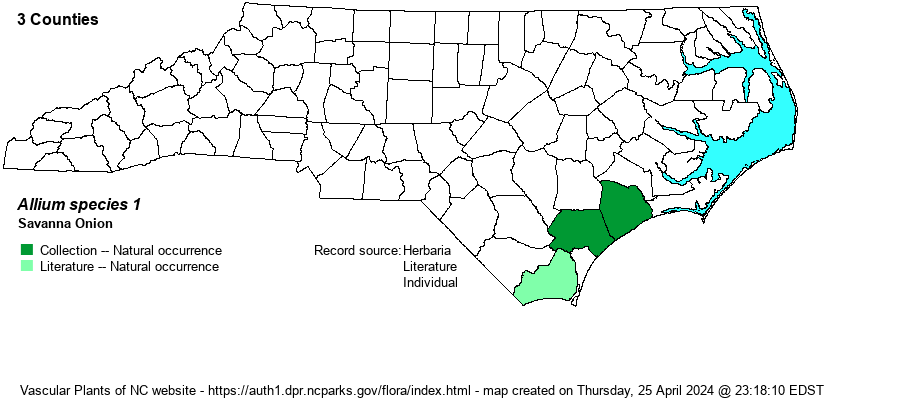| Author | | |
| Distribution | This undescribed taxon, almost certainly a good species, is known only from several counties in the southeastern corner of the state -- Onslow, Pender, and Brunswick. It is an NC endemic.
This taxon has yet to be found in neighboring SC, and thus its entire range is southeastern NC. | |
| Abundance | Though rare in the southeastern coastal counties, it is locally uncommon to fairly common on those few savannas with somewhat circumneutral soils, underlain by marl. Though it would merit official state listing as Endangered or Threatened, an undescribed taxon cannot be listed legally for State or Federal protection. Thus, it is given only a Significantly Rare status, as assigned by the NC NHP. | |
| Habitat | This taxon is limited to wet savannas over coquina limestone (marl). Perhaps at each of the roughly 12 known sites, additional rare plants are found, especially ones favoring such high pH soils, including Thalictrum cooleyi, Carex lutea, and Parnassia caroliniana. Owing to the great rarity of the taxon and the additional species, most or all sites are included within identified natural areas (as defined by the NC NHP). |
| Phenology | Blooms quite late for an Allium species -- from late August to early October; fruits from late September into November. | |
| Identification | This taxon, certainly a good species, looks quite similar to Nodding Onion (Allium cernuum), but it has a much later blooming period, a different range separated by nearly all of the Coastal Plain where neither occurs, and by habitat (this taxon favoring damp ground and A. cernuum often in dry soil of glades, barrens, and other upland grassy places). It has a flowering stalk reaching about 1-1.5 feet tall, but with a nodding umbel. The numerous flowers can vary from white to pale purple, but averaging pink in color; the tepals are longer than on A. cernuum, being 6-9 mm (nearly 1/3-inch long) as opposed to 5-6.5 mm (about 1/4-inch or less long). The basal leaves are more strongly keeled than in A. cernuum, and they are slightly wider as well. However, as the ranges of the two species are greatly separated, as are the habitats and flowering dates, you will not need to worry about characters to separate the two. A stand of these onions in bloom is quite spectacular, and as it blooms in the very late summer and fall, there are often many other plants (such as composites) in bloom near or with it. | |
| Taxonomic Comments | For several decades this taxon has simply been named as "Allium species 1", or "Allium new species". People who have seen both species are certain this taxon is indeed a good species, and all it seems to need is a scientific description. Such a description is also needed to afford it some legal State and possibly Federal protection. Why a formal description of this taxon is still lacking (in 2022) is puzzling.
| |
| Other Common Name(s) | Probably none | |
| State Rank | S1S2 | |
| Global Rank | G1G2 | |
| State Status | SR-L | |
| US Status | | |
| USACE-agcp | | |
| USACE-emp | | |

